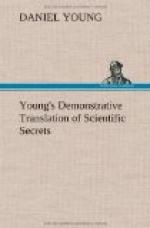179. General directions for bronzing
This art is nothing but a species of painting, but far from being of the most delicate kind. The principal ingredients made use of in it are the true gold powder, the German gold, the aurum mosaicum, and copper powder, (all above described.) The choice of these powders is, of course, to be determined by the degree of brilliancy you wish to obtain. The powder is mixed with strong gum water or isinglass, and laid on with a brush or pencil; and when not so dry as to have still a certain clamminess, a piece of soft leather wrapped round the finger, is dipped in the powder and rubbed over the work; when the work has been all covered with the bronze, it must be left to dry, and any loose powder then cleared away by a hair pencil.
180. Bronzing in wood
This may be effected by a process somewhat differing from the above, Prussian blue, patent yellow, raw amber, lamp-black, and pipe clay are ground separately with water on a stone, and as much of them as will make a good colour put into a small vessel three-fourths full of size. This mixture is found to succeed best on using about half as much more pipe clay as of any of the other ingredients. The wood being previously cleaned and smoothed, and coated with a mixture of clean size and lamp-black, receives a new coating with the above compound twice successively, having allowed the first to dry. Afterwards the bronze powder is to be laid on with a pencil, and the whole burnished or cleaned anew, observing to repair the parts which may be injured by this operation; next, the work must be coated over with a thin lather of castile soap, which will take off the glare of the burnishing, and afterwards be carefully rubbed with a woollen cloth. The superfluous powder may be rubbed off when dry.
181. In bronzing iron
The subject should be heated to a greater degree than the hand can bear; and German gold, mixed with a small quantity of spirit of wine varnish, spread over it with a pencil; should the iron be already polished, you must heat it well and moisten it with a linen rag dipped in vinegar.
182. Bronzing casts of plaster of Paris
There is a method of bronzing casts of plaster of Paris analogous to that which we have above given for bronzing wood, but it is not in much repute. Such figures may be beautifully varnished by means of Dr. John’s varnish, receipt No. 178. Casts of plaster of Paris may be made by receipt No. 167.
183. Shell-lac varnish
Dissolve in an iron kettle, one part of pearl-ash in about 8 parts of water; add one part of shell-lac, and heat the whole to ebullition. When the lac is dissolved, cool the solution, and impregnate it with chlorine, till the lac is all precipitated. The precipitate is white, but its colour deepens by washing and consolidation; dissolved in alcohol, lac bleached by the above process yields a varnish which is as free from colour as any copal varnish.




